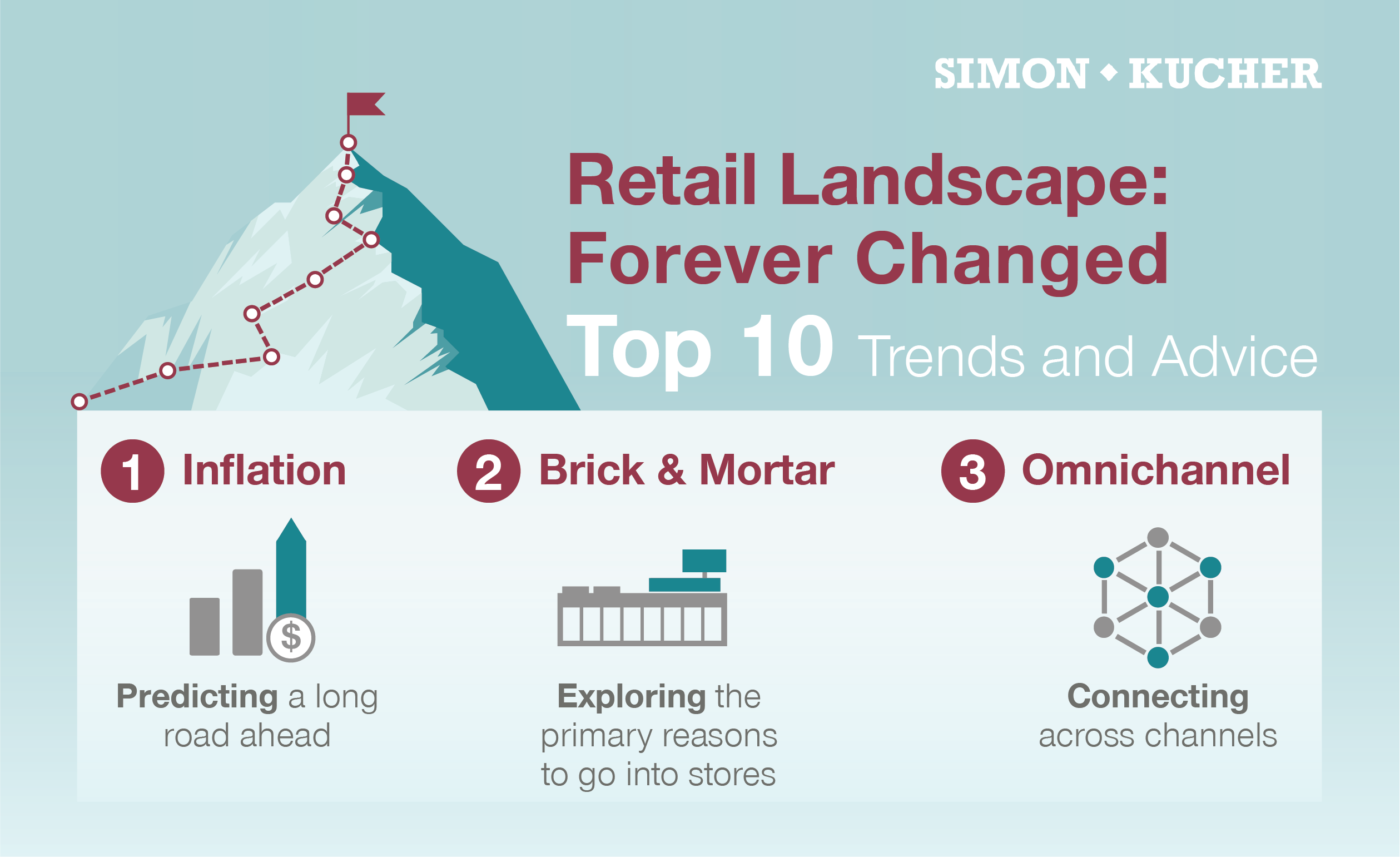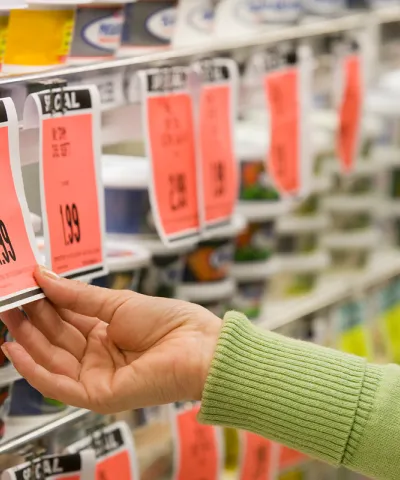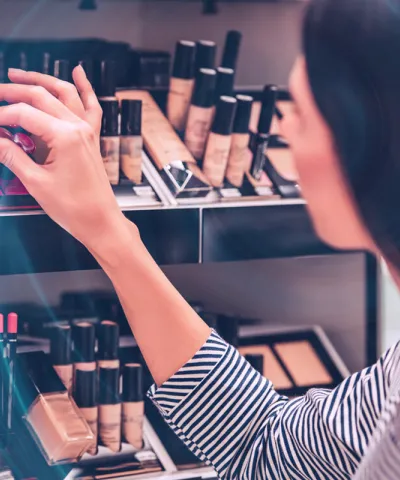Unpredictability. Volatility. Adaptability. Digitalization. Transformation.
These are some of the words that come to mind when describing how the retail landscape has recently changed. The pandemic and global events have created new opportunities for consumers, including how they shop, behave, use and experience goods and services. Most retailers are striving to adapt to these ever-changing needs and the macroeconomic uncertainties that add to the complexity of challenge.
While we don’t have a crystal ball into the future, we’d like to share our perspective on what’s happening now to hopefully provide valuable guidance to anticipate what’s next. Below, we’ve identified the Top 10 trends for retailers to consider for their existing and future commercial and go-to-market strategies.
1. Inflation, inflation, inflation
Inflation has been on the mind of the consumer since May 2021 and shows no signs of going away any time soon. Exacerbated by supply chain woes, increasing interest rates, falling consumer optimism, and humanitarian crises in Europe, we anticipate a long road ahead before inflation stabilizes.
How retailers can act: Avoid typical knee-jerk reactions to peanut butter spread price increases in hopes of covering margins or following competitors. These tactics provide a short-term fix and can endanger long-term growth, as consumers may reject increases and walk, or low-cost disrupters may enter the market. Instead, companies should consider developing differentiation and granularity alongside surgical or strategic price increases that are based on the current and future consumer value, incorporate roles of products and services, and take into account different target segments. Be sure to leverage clear communication and transparent messaging, which is critical for consumer retention. For more insight into a structured pricing approach to tackle inflation, read more here.
2. Brick-and-mortar (b&m) serves a new purpose
Lockdowns and COVID-19 made it necessary for consumers to shop from the comfort of their own home with increased frequency and intensity than ever before. The primary reasons to go into stores – to feel, touch, and try a product – are much harder to replicate with online shopping.
How retailers can act: Capitalize on using brick-and-mortar locations to create experiences for consumers rather than as a static showroom and explore new formats such as shop-in-shop and brand collaborations. Listen to what your consumers want from in-person shopping and provide the benefits and curated experiences that they cannot receive online. Combine this with a smart inventory strategy to prioritize the items that require a trip to the store (e.g., in-demand and time-sensitive items) to encourage browsing and upsell.
3. Omnichannel is table stakes
Consumers demand the best of both worlds: they want to go back to brick-and-mortar stores while still having access to all the benefits and convenience of e-commerce. Nothing showcases this trend better than the 2021 holiday shopping season, where we saw that 27% more consumers wanted to shop in-store, and 16% wanted to shop online compared to the year before.
How retailers can act: Companies should consider the following when developing their omnichannel strategy:
- Define clear roles for each channel: Direct-to-consumer channels are great for building brand and controlling narrative while wholesale partners can help drive awareness and volume.
- Provide an enriched experience between online and in-person shopping: Allow consumers to choose how they want to browse versus acquire products with a mix of delivery and pick up options. Companies can also incorporate shopping formats that are conducive for each channel (e.g., size and texture in person vs. product reviews online).
- Track and influence purchase behavior across channels: Enhance omnichannel browsing and purchasing through account management and loyalty programs. Use the information to create more personalized recommendations and offers for an elevated consumer experience.
4. Amazon overshadows the competition
Amazon continues to make permanent changes to the shopping landscape. According to Simon-Kucher & Partners’ holiday study, Prime Day has surpassed Cyber Monday as the second-largest deal day of the year, behind only Black Friday. Additionally, the pandemic increased Amazon Prime membership by 23%, and the number of brands that participate in the Amazon platform increased by 40%. Competitors are even running similar promotions on Amazon Prime Days to compete for share of wallet.
How retailers can act: While many companies see Amazon as an awareness building and sales driving channel, many do not have a clear merchandising strategy that optimizes use of that channel. A strong Amazon merchandising strategy focuses on three primary success factors:
- Product assortment and architecture positioning: Utilize product hierarchies to group products and reviews together and identify hero SKUs as part of search results to drive consumers to product pages.
- Paid media strategy: While it seems simple, many companies forget to define the primary and secondary goals for each paid media campaign. Once set, review and define the campaign structure, bid optimization rules, and keyword harvesting rules to ensure the campaigns meet goals.
- Search engine optimization (SEO): Use impactful and relevant keywords to increase discoverability of products. Supporting product page images and titles that clearly communicate the benefits of the product increase click-throughs and conversion rates. Also, implement quality backlink building and conduct backlinks monitoring to improve your website reach.
5. Fast and furious delivery
The last mile delivery landscape is constantly evolving: it includes start-ups and pure play delivery companies (JOKR, Instacart), restaurant delivery apps (Doordash, Uber Eats), disintermediation by grocery (Kroger, Stop & Shop) and even mom and pop stores that are servicing their neighborhoods. Consumers have full flexibility (can buy in store, pick up in store, etc.) and are putting greater value on their time. However, while everyone seems to be racing to offer the fastest delivery, there is reason to believe there is limited long-term feasibility of such aggressively short delivery times.
How retailers can act: The challenge for delivery providers will be to differentiate their unique value proposition to find a model that is sustainable on a per order basis. While customer acquisition may be the ultimate goal, it is just as important to focus on building customer lifetime value through loyalty programs, subscriptions, and pricing. This can be done via fencing through price metrics (the types of fees charged such as premiums for speedier deliveries), price models (e.g., tiered, scaling, flat, etc.) and price levels that are aligned to willingness-to-pay while remaining competitive and profitable.
6. Stretching spend with buy now, pay later
As people try to make the most of their money, “buy now, pay later” (BNPL) is becoming red-hot for e-commerce, encouraging shoppers to spend more than they normally would. In fact, 29 million Americans have used BNPL for at least one transaction in the past year. This new way of purchasing is expected to grow quickly and could account for nearly a quarter of e-commerce transactions over the next four years.
How retailers can act: While BNPL may be a growing trend, it is important to understand BNPL trends in your industry, the potential impact in both the near-term and long-term, and the key objectives for the payment model. Key questions to ask include:
- Which consumer segments do you want to target and does BNPL appeal to those segments?
- Do you unlock new segments with BNPL?
- How do BNPL segment profiles differ in terms of brand loyalty and CLTV?
- How will BNPL affect your brand’s perception?
- What is the financial risk (e.g., default rates) and how will accounting have to change?
7. All eyes on Environmental, Social & Governance (ESG) positioning
As social, environmental, and community values are becoming a greater part of our everyday lives, there’s a growing movement by consumers to buy from brands that reflect their own values. This is further intensified as consumers have more options than ever, and it’s easier to find like-minded companies that meet more than just basic needs for products or services. In mid-2020, the majority of Millennials (75 percent) and GenZers (63 percent) altered their shopping behavior to align with brands they relate to regarding sustainability, community, social responsibility, and ethical business practices.
How retailers can act: Companies should consider actively developing and communicating their company values and mission if they have not done so already. Silence on these issues can be perceived negatively. Creating a culture and relationship with your consumers that includes transparency and authenticity can lead to long-term success. Developing and broadcasting your ESG goals, as well as acknowledging mistakes, can help build a community and consumers can celebrate your wins with you. On the flipside, if and when mistakes are made, sincerely acknowledge them and provide insight into rectification actions.
8. Sustainable sustainability
Our studies show that sustainability has become the expectation rather than the exception when it comes to consumer behaviors and decisions, especially amongst Millennials and Gen Z. Companies that focus on making sustainable decisions will have the advantage. The importance of eco-friendly views is growing in scope and strength in the very generations poised for increased future spending, which can present potential downside for those who act too late.
How retailers can act: The key is to maintain full commercial feasibility while pursuing concrete, actionable steps towards sustainability. When setting your company’s overall sustainability strategy, prioritize what kind of consumer your brand will and will not target. As sustainability grows in importance for more and more consumers, understand that you may lose consumers if you are not sustainable.
9. Made for you: make it personal
Companies are collecting so much data that consumers expect (within ethical boundaries) companies can discern individual preferences and provide optimal product recommendations and promotions. As options continue to increase for consumers, curated goods and services are more likely to catch consumers’ eyes, share of wallet, and repeat business.
How retailers can act: Companies should consider adopting a differentiated, data-driven, automated, and targeted process instead of a one-size-fits all marketing approach. To accomplish this, companies should identify the consumer segments that provide the greatest opportunity in both customer lifetime value and the right to win. Retailers can continuously analyze purchase patterns to identify key value drivers such as time of purchases, size of purchase, channel, product roles, and communication pathways. Utilize automation tools to apply these insights to develop personalized and curated offers.
10. New shopping frontiers
Companies and retailers are pursuing new and creative shopping experiences to garner consumers’ attention. Some of the more notable examples include:
- Virtual experiences (such as around-the-world shopping provided by Airbnb)
- Livestream shopping has also become more popular, with brands such as Amazon developing its own platforms
- Competitor collaborations to bring new limited-edition products, such as the partnership between Allbirds and Adidas
- Potential for the metaverse and virtual shopping
- Accepting cryptocurrencies as methods of payment
- ...as well as Pop up shops, selling on Instagram, shop-in-shop, and more
How retailers can act: Before launching the next great shopping experience, think about how your consumer shops, what formats would best impact your corporate objectives, and your feasibility to pursue different formats to capture increased interest and value. Ask yourself questions such as:
- How to best use experiential formats to create a compelling experience for consumers that want to interact with their brands before purchase?
- What’s the right collaboration to pursue to improve brand perception or change/elevate your brand?
- How do you use everything that's at your fingertips to optimize the customer journey?
Conclusion: Retailers need to get ready for the future now!
Everything is changing drastically and the old playbook will no longer work. If you’d like to learn more about how to take advantage of these trends and go-to-market strategies, reach out to our experts, Shikha Jain, and Hubert Paul.









